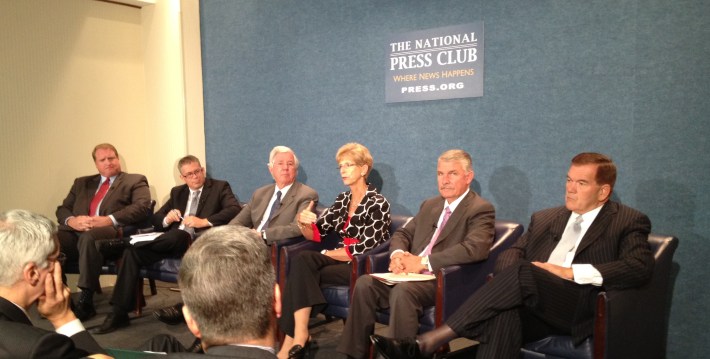
As yesterday's post about Oklahoma City's fight to replace a downtown highway with a real urban boulevard illustrated so well, cities are often at the vanguard of smart urban planning and transportation choices while state-level agencies can be laggards. So it's nice to see some governors and ex-governors stepping forward to emphasize the value of smart growth policies.
The Governors' Institute on Community Design isn't a brand new undertaking -- it's been around since 2005 -- but it's just gotten some high-profile support which could catapult it to a different level.
Yesterday, a bipartisan group of six governors and ex-governors celebrated the new support of the Partnership for Sustainable Communities -- the collaboration of HUD, DOT, and EPA -- for the Governor's Institute. This kind of collaborative work, among federal agencies and with the states, is "common sense writ large," said U.S. DOT Deputy Secretary John Porcari at the event. "But it wasn't done in the past."
States are where the rubber hits the road, he said, and the federal government needs to help them take smart action.
The Institute's staff advises states on everything from agriculture and economic development to transportation and housing. They hold workshops in states, hosted by the governors themselves, to give specific advice tailored to the needs and particularities of that places.
Its prescriptions are well grounded in the smart growth philosophy. For example, the Institute's 14 policies for transportation include strategic planning, a "fix-it-first" approach, and complete streets. They evaluate communities based on street grid connectivity and transit-oriented development, not old-school criteria like vehicle level-of-service.
The state executives assembled yesterday agreed that whatever their interest in land use and urban design, the bottom-line issue for any governor is jobs and economic development. That's what they're going to run on in the next election, not their improved stormwater management or connected street grid. And sometimes, the pressure to launch a project quickly in order to create jobs means that adequate planning gets shortchanged, according to James Lee Witt, former FEMA director, who spoke at yesterday's event.
But the economic question goes far deeper than just temporary construction jobs. As William Fulton, vice president for policy and programs at Smart Growth America and former mayor of Ventura, California, blogged this week on CNN.com, "Where businesses go, where houses go, where roads go, where sidewalks go, where farms and natural spaces go – all of these things collectively affect a community’s economic performance and the cost of providing services there. Put things closer together, the services cost less. Put things farther from each other, the services cost more for the jurisdiction and its taxpayers."
These governors are recognizing the hidden costs of greenfield development and trying to save their states the financial headaches that come with it. "When sprawling new development happens, it’s easy to mistake that for prosperity," Fulton wrote. "New buildings and wide roads look great when they first meet the eye. But... every time a new, spread-out subdivision is built far away from existing infrastructure, somebody has to pay for a bunch of roads that serve a small number of residents. And sewer and water lines too. And fire trucks that must travel farther to serve fewer people. And police cars. And ambulances. And school buses. And dial-a-ride buses. And – in many parts of the country – snowplows."
A recognition of those costs led Tom Ridge, when he was governor of Pennsylvania, to start a "land recycling" program -- essentially, incentives for brownfield development. He said overzealous environmental regulation required developers to clean up infill sites "to background" -- to its most pristine condition -- when that wasn't always necessary. "There needs to be a different cleanup standard whether you're building a playground or a new industrial site," he said.
Christie Todd Whitman, former Republican governor of New Jersey, oversaw a rezoning program called "Upstairs Downtown" so that business owners could live above their stores -- which had been previously illegal. She also changed codes that made it cheaper to tear down buildings than renovate them and relaxed disability accommodations that outlawed front stoops. The current governor of her state, Chris Christie, is probably best known in transportation and planning circles for killing the ARC trans-Hudson transit tunnel. But his deputy chief of staff for policy and planning Wayne Hasenbalg said that even Christie has taken advantage of advice from the Governors' Institute to "develop a strategic and thoughtful approach to economic development that includes directing growth to places that not only create the greatest return on the state’s investment, but also create great communities for the citizens of New Jersey." (Perhaps the Governor's Institute could impart some wisdom regarding the "American Dream" mega-mall currently taking shape in a swamp.)
The Governors' Institute has provided advice and technical assistance to the fastest growing state in the nation, Arizona, as well as smaller and less dynamic states like Delaware and Rhode Island.
When I asked Ridge why state officials so often seem to have more affinity for their suburban residents than their urban ones, he said the issue wasn't state versus city versus suburb. He encouraged governors to think regionally and to develop regional plans for economic development and for travel and tourism.
He also made it clear that the country will never get off the financial cliff it's on through spending reductions. He's holding out hope, however dim, that the next Congress will have the courage to find new revenues. "The orthodoxy on our side of the aisle is 'no new revenue,'" he said. "That doesn't make sense."
Still, he said, "I'm not going to give the federal government a dime of additional revenue until we make some changes," echoing the sentiments of how many a metro Atlanta voter feels about the state government.





